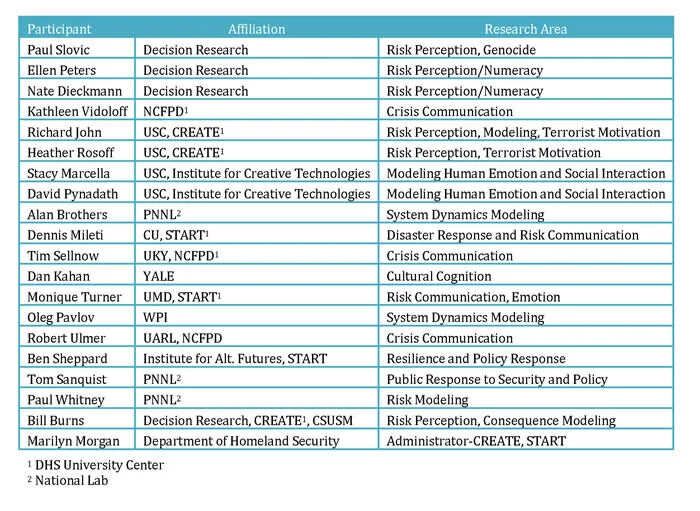Public Response to Threat
Cross-Disciplinary Contributions and Collaboration
Acknowledgments
We would like to acknowledge Pacific Northwest National Labs (PNNL), Decision Research, and CREATE for all their organizational support for this workshop. Many behind-the-scene details were required and their help was pivotal. Vicki Groves and Jane Hays from PNNL handled the travel arrangements. Buffee Finn from Decision Research set up the meeting facilities and found the ideal restaurants and hotel in Eugene. Leisha Wharfield from Decision Research posted all the workshop presentations and simulation exercises. And of course a special thanks to all the researchers who participated and contributed to the workshop’s success.
This workshop was supported by the United States Department of Homeland Security through the National Center for Risk and Economic Analysis of Terrorism Events (CREATE) under grant number 2007-ST-061-000001, and the National Science Foundation under grant number SES 0728934. However, any opinions, findings, and conclusions or recommendations in this document are those of the authors and do not necessarily reflect views of the United States Department of Homeland Security or the National Science Foundation.
Participants
The Psychology of Risk – Paul Slovic (Decision Research)
Research Needs Regarding Public Warnings and Social Media – Dennis Mileti (START, CU)
Resilience and Preparedness for Strategic Terrorism – Ben Sheppard (Institute for Alternative Futures)
Risk Assessment for Scenarios – Paul Whitney (Pacific Northwest National Lab)
Public Response: Causes, Consequences & Mitigation – Bill Burns (Decision Research, CREATE, CSUSM)
Numeracy and Risk Perception – Ellen Peters (Decision Research)
Risk Perception: Driving Factors – Heather Rosoff (CREATE, USC) and Richard John (CREATE, USC)
Using System Dynamics to Model Risk Perception and Communication in Response to Threat – Oleg Pavlov (WPI) and Alan Brothers (Pacific Northwest National Lab)
Modeling the Role of Theory of Mind in Social Interaction and Influence – David V. Pynadath and Stacy Marsella (Institute for Creative Technologies, USC)
Panel and Group Simulation Exercise: The City of Los Angeles experiences a terrorist inspired biothreat (we’ll use a scenario CREATE researchers have developed concerning a genetically modified flu strain). The group will breakup into five teams to adopt the risk perspective of either a recent U.S. arrival, health care worker, member of the clergy, business owner or government employee. The focus will be on understanding how different publics are likely to respond, how perceptions and risk-related behaviors may emerge amidst a crisis, and how risk perception research is likely to be relevant.
Cultural Cognition and Risk Communication – Dan Kahan (Cultural Cognition Project, Yale)
Opportunities and Confounding Issues in Risk and Crisis Communication – Tim Sellnow (NCFPD, UKY), Kathleen Vidoloff (UKY, NCFPD), and Robert Ulmer (UALR, NCFPD)
Emotion, Cognition and Risk Communication– Monique Turner (START, UMD)
An Exploratory Risk Perception Study of Attitudes Toward Homeland Security Systems – Tom Sanquist (Pacific Northwest National Lab)
Panel and Group Simulation Exercise: The City of Los Angeles experiences a dirty bomb attack in its downtown financial district. The entire group will think about the nature and timing of risk messages targeted at different populations and implemented by different actors (e.g. mayor, fire chief, governor). As before panel members will offer observations and comments. The focus will be on articulating what we know and need to know to recommend effective risk messaging for our urban centers.


